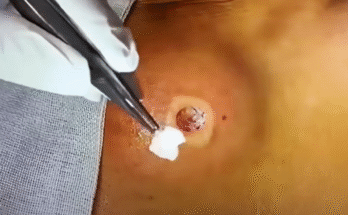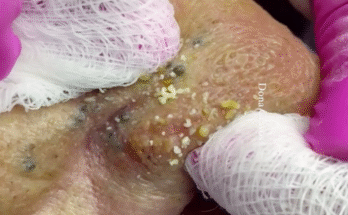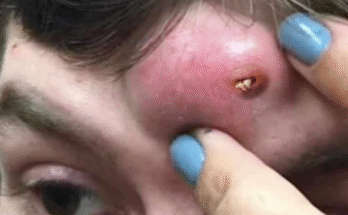An earlobe cyst—sometimes just called a bump on the earlobe—is usually a harmless, non-cancerous lump that forms under the skin. The most common type is a sebaceous cyst or epidermoid cyst, and it can appear smooth, round, and slightly mobile when touched.
 What Exactly Is an Earlobe Cyst?
What Exactly Is an Earlobe Cyst?
A cyst on the earlobe is a closed sac filled with:
-
Keratin (a protein found in skin)
-
Sometimes sebum (an oily substance)
-
It develops when a sebaceous gland or hair follicle becomes blocked.
These cysts are also referred to as:
-
Epidermoid cysts
-
Sebaceous cysts (technically a bit different, but often used interchangeably)
 Causes of Earlobe Cysts
Causes of Earlobe Cysts
-
Blocked hair follicle or gland
-
Trauma or piercing (common around earlobes!)
-
Genetic predisposition
-
Skin conditions like acne
 Symptoms
Symptoms
-
Small, round bump under the skin
-
May be painless or slightly tender
-
Can grow slowly over time
-
If infected:
-
Redness, swelling
-
Pain
-
Pus or discharge
-
Warmth in the area
-
 Diagnosis
Diagnosis
A doctor usually identifies an earlobe cyst through physical examination. No biopsy or scan is needed unless the bump is:
-
Unusually large
-
Painful
-
Recurring
-
Changing shape or color
 Treatment Options
Treatment Options
| Treatment | When It’s Used | Details |
|---|---|---|
| Watchful waiting | If it’s small & not bothering you | Many cysts go away or stay small without treatment |
| Warm compresses | For minor irritation or drainage | Can help ease discomfort & promote drainage |
| Antibiotics | If infected | May be oral or topical |
| Drainage | For painful or pus-filled cysts | Done by a doctor—relieves pressure |
| Surgical removal | For recurring or large cysts | Minor procedure done under local anesthesia |
Never try to pop it at home—this can cause infection or scarring.
An earlobe cyst, commonly referred to as an epidermoid cyst, is a benign, non-cancerous lump that forms beneath the skin of the earlobe. These cysts are typically filled with keratin, a protein produced by skin cells, and are often painless unless infected or inflamed.
Causes
Earlobe cysts develop when skin cells that should shed instead become trapped beneath the skin’s surface. This entrapment leads to the formation of a sac that secretes keratin, resulting in a cyst. Common causes include:
Blocked hair follicles or sebaceous glands: Often due to trauma or skin conditions like acne.
Piercings: Earlobe piercings can introduce bacteria or cause irritation, leading to cyst formation.
Genetic factors: A family history of cysts may increase the risk.
Skin injuries: Damaged skin can cause cells to react abnormally, forming cysts. Healthline
Symptoms
Earlobe cysts typically present as:
Small, round bumps beneath the skin.
Painless or mildly tender unless infected.
Slow-growing over time.
Occasionally inflamed with redness, swelling, and warmth if infected.
Possible discharge of a foul-smelling, thick substance if the cyst ruptures. Healthline
Diagnosis
Diagnosis is primarily clinical, based on physical examination. In some cases, a biopsy may be performed to rule out other conditions.
Treatment Options
1. Observation
If the cyst is small, painless, and not causing cosmetic concerns, it may be left untreated. Many cysts remain stable or resolve on their own.
2. Warm Compresses
Applying a warm, moist cloth to the cyst can help reduce inflammation and encourage drainage, especially if the cyst is inflamed but not infected. Mayo Clinic
3. Steroid Injections
Injections of corticosteroids can reduce inflammation and may shrink the cyst. This is typically used for cysts that are inflamed but not infected.
4. Incision and Drainage
A healthcare provider makes a small incision in the cyst to drain its contents. This provides temporary relief but does not remove the cyst wall, so recurrence is common.
5. Surgical Removal
Complete excision of the cyst, including its wall, is the most effective treatment to prevent recurrence. This procedure is typically performed under local anesthesia and may leave a small scar. Mayo Clinic
When to See a Doctor
Consult a healthcare provider if:
The cyst becomes painful, red, or swollen.
There is a noticeable increase in size.
The cyst ruptures or drains pus.
You have concerns about the appearance or location of the cyst.
Additional Considerations
In rare cases, earlobe cysts can become quite large or recurrent. For instance, a case study reported a giant earlobe epidermoid cyst measuring 7.5 × 6 cm, which was successfully removed without recurrence. Another study highlighted the importance of identifying underlying epidermoid cysts in recurrent earlobe keloids, as their removal led to successful treatment. IJORL+2PMC+2PubMed+2PubMed
https://youtube.com/shorts/vWem2tWW1L4?si=539QS8QIcGHJKceu



